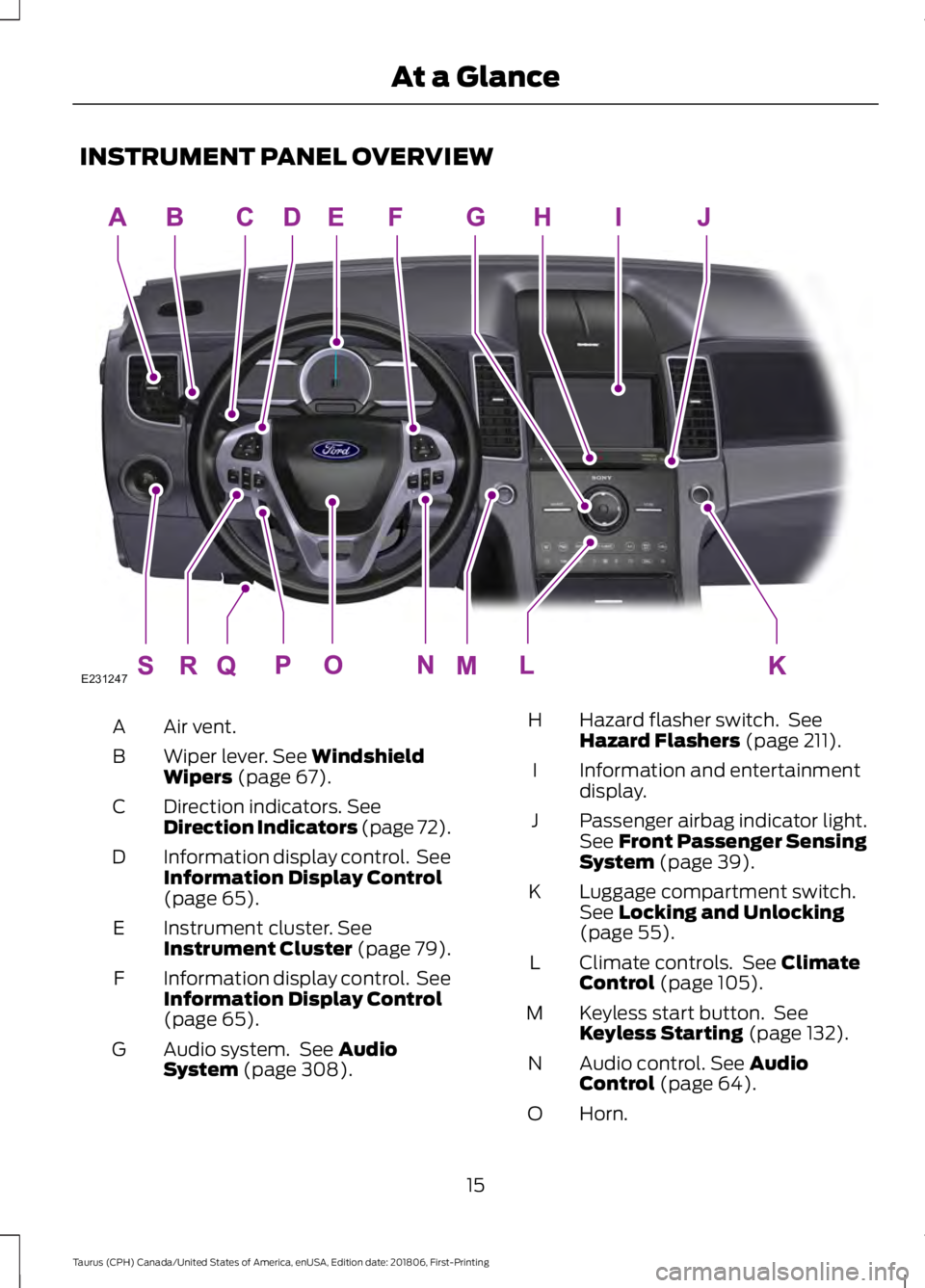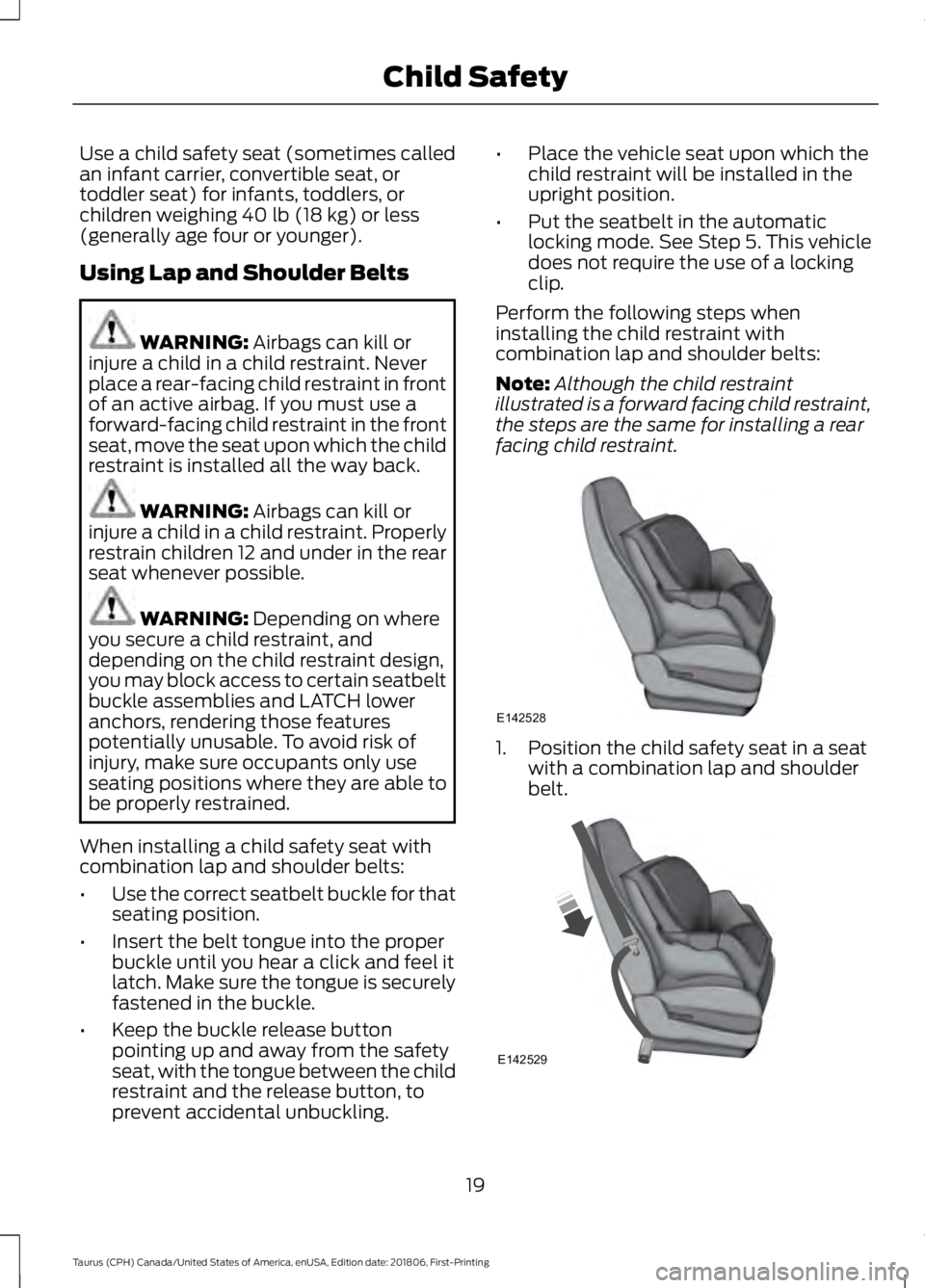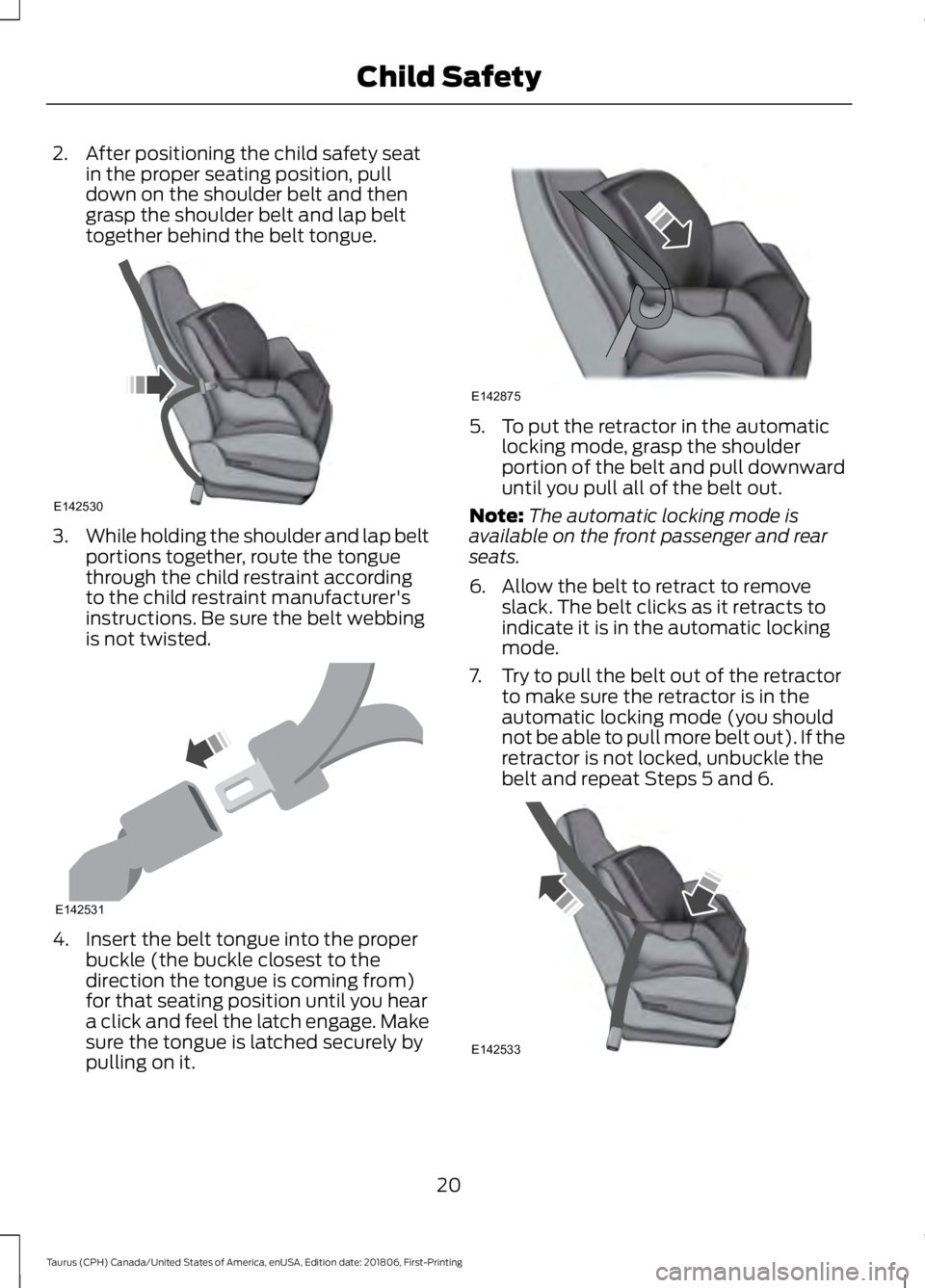2019 FORD TAURUS lock
[x] Cancel search: lockPage 4 of 515

Introduction
About This Manual
..........................................7
Symbols Glossary ............................................
7
Data Recording .................................................
9
Perchlorate ........................................................
11
Ford Credit .........................................................
11
Replacement Parts Recommendation ........................................................................\
....
12
Special Notices ...............................................
12
Mobile Communications Equipment ........................................................................\
....
13
Export Unique Options .................................
13
Environment
Protecting the Environment .......................
14
At a Glance
Instrument Panel Overview ........................
15
Child Safety
General Information ......................................
17
Installing Child Restraints ...........................
18
Booster Seats .................................................
24
Child Restraint Positioning ........................
26
Child Safety Locks ........................................
28
Seatbelts
Principle of Operation .................................
29
Fastening the Seatbelts .............................
30
Seatbelt Height Adjustment .....................
32
Seatbelt Warning Lamp and Indicator Chime .............................................................
32
Seatbelt Reminder ........................................
33
Child Restraint and Seatbelt Maintenance ...............................................
34
Seatbelt Extension .......................................
35
Personal Safety System ™
Personal Safety System ™.........................
36 Supplementary Restraints
System
Principle of Operation ..................................
37
Driver and Passenger Airbags ..................
38
Front Passenger Sensing System ...........
39
Side Airbags .....................................................
41
Safety Canopy ™............................................
42
Crash Sensors and Airbag Indicator ......
44
Airbag Disposal ..............................................
45
Keys and Remote Controls
General Information on Radio Frequencies ................................................
46
Remote Control .............................................
46
Replacing a Lost Key or Remote Control ........................................................................\
..
50
MyKey ™
Principle of Operation ..................................
51
Creating a MyKey ...........................................
52
Clearing All MyKeys ......................................
52
Checking MyKey System Status ..............
53
Using MyKey With Remote Start Systems ........................................................
53
MyKey Troubleshooting ..............................
53
Doors and Locks
Locking and Unlocking ................................
55
Keyless Entry ..................................................
58
Interior Luggage Compartment Release ........................................................................\
..
60
Security
Passive Anti-Theft System ........................
62
Anti-Theft Alarm ...........................................
63
Steering Wheel
Adjusting the Steering Wheel ..................
64
Audio Control .................................................
64
Voice Control ..................................................
64
1
Taurus (CPH) Canada/United States of America, enUSA, Edition date: 201806, First-Printing Table of Contents
Page 6 of 515

Starting and Stopping the
Engine
General Information ....................................131
Ignition Switch ...............................................
131
Keyless Starting ............................................
132
Starting a Gasoline Engine .......................
132
Engine Block Heater ...................................
134
Fuel and Refueling
Safety Precautions ......................................
136
Fuel Quality - E85 .......................................
136
Fuel Quality - Gasoline ..............................
138
Fuel Filler Funnel Location .......................
138
Running Out of Fuel ...................................
138
Refueling ........................................................
140
Fuel Consumption .......................................
143
Engine Emission Control
Emission Law ................................................
145
Catalytic Converter .....................................
146
Transmission
Automatic Transmission ..........................
149
All-Wheel Drive
Using All-Wheel Drive ................................
153
Brakes
General Information ...................................
160
Hints on Driving With Anti-Lock Brakes ........................................................................\
..
161
Parking Brake .................................................
161
Hill Start Assist ..............................................
161
Traction Control
Principle of Operation ................................
163
Using Traction Control ...............................
163Stability Control
Principle of Operation
...............................
164
Using Stability Control ..............................
165
Parking Aids
Principle of Operation ................................
167
Rear Parking Aid ...........................................
167
Active Park Assist ........................................
168
Rear View Camera .......................................
172
Cruise Control
Principle of Operation ................................
176
Using Cruise Control ...................................
176
Using Adaptive Cruise Control ................
177
Driving Aids
Driver Alert .....................................................
183
Lane Keeping System ................................
184
Blind Spot Information System .............
189
Cross Traffic Alert .........................................
191
Steering ...........................................................
194
Collision Warning System ........................
194
Load Carrying
Load Limit .......................................................
197
Towing
Towing a Trailer ...........................................
202
Recommended Towing Weights ..........
203
Essential Towing Checks .........................
204
Towing the Vehicle on Four Wheels .....
206
Driving Hints
Breaking-In ....................................................
207
Economical Driving ....................................
207
Driving Through Water .............................
208
Floor Mats .....................................................
208
3
Taurus (CPH) Canada/United States of America, enUSA, Edition date: 201806, First-Printing Table of Contents
Page 10 of 515

ABOUT THIS MANUAL
Thank you for choosing Ford. We
recommend that you take some time to
get to know your vehicle by reading this
manual. The more that you know about
your vehicle, the greater the safety and
pleasure you will get from driving it.
WARNING: Driving while
distracted can result in loss of vehicle
control, crash and injury. We strongly
recommend that you use extreme
caution when using any device that may
take your focus off the road. Your
primary responsibility is the safe
operation of your vehicle. We
recommend against the use of any
hand-held device while driving and
encourage the use of voice-operated
systems when possible. Make sure you
are aware of all applicable local laws
that may affect the use of electronic
devices while driving.
Note: This manual describes product
features and options available throughout
the range of available models, sometimes
even before they are generally available. It
may describe options not fitted to the
vehicle you have purchased.
Note: Some of the illustrations in this
manual may show features as used in
different models, so may appear different
to you on your vehicle.
Note: Always use and operate your vehicle
in line with all applicable laws and
regulations.
Note: Pass on this manual when selling
your vehicle. It is an integral part of your
vehicle.
This manual may qualify the location of a
component as left-hand side or right-hand
side. The side is determined when facing
forward in the seat. Right-hand side.
A
Left-hand side.
B
SYMBOLS GLOSSARY
These are some of the symbols you may
see on your vehicle. Air conditioning system
Air conditioning system lubricant
type
Anti-lock braking system
Avoid smoking, flames or sparks
Battery
Battery acid
Brake fluid - non petroleum
based
Brake system
7
Taurus (CPH) Canada/United States of America, enUSA, Edition date: 201806, First-Printing IntroductionE154903 E162384 E231157
Page 11 of 515

Brake system
Cabin air filter
Check fuel cap
Child safety door lock or unlock
Child seat lower anchor
Child seat tether anchor
Cruise control
Do not open when hot
Engine air filter
Engine coolant
Engine coolant temperature
Engine oil
Explosive gas
Fan warning
Fasten seatbelt Flammable
Front airbag
Front fog lamps
Fuel pump reset
Fuse compartment
Hazard flashers
Heated rear window
Windshield defrosting system
Interior luggage compartment
release
Jack
Keep out of reach of children
Lighting control
Low tire pressure warning
Maintain correct fluid level
Note operating instructions
8
Taurus (CPH) Canada/United States of America, enUSA, Edition date: 201806, First-Printing IntroductionE270480 E71340 E71880 E231160 E67017 E161353
Page 12 of 515

Horn control
Panic alarm
Parking aid
Parking brake
Power steering fluid
Power windows front/rear
Power window lockout
Requires registered technician
Safety alert
See Owner's Manual
See Service Manual
Service engine soon
Passenger airbag activated
Passenger airbag deactivated
Side airbag Shield the eyes
Stability control
Hill descent control
Trail control
Windshield wiping system
Windshield wash and wipe
DATA RECORDING
Service Data Recording
Service data recorders in your vehicle are
capable of collecting and storing
diagnostic information about your vehicle.
This potentially includes information about
the performance or status of various
systems and modules in the vehicle, such
as engine, throttle, steering or brake
systems. In order to properly diagnose and
service your vehicle, Ford Motor Company
(Ford of Canada in Canada), and service
and repair facilities may access or share
among them vehicle diagnostic
information received through a direct
connection to your vehicle when
diagnosing or servicing your vehicle.
Additionally, Ford Motor Company (Ford
of Canada, in Canada) may, where
permitted by law, use vehicle diagnostic
information for vehicle improvement or
with other information we may have about
you, (for example, your contact
information), to offer you products or
services that may interest you. Data may
be provided to our service providers such
9
Taurus (CPH) Canada/United States of America, enUSA, Edition date: 201806, First-Printing IntroductionE270945 E139213 E231159 E231158 E270849 E270850 E167012 E138639 E163957 E272858 E270969
Page 18 of 515

INSTRUMENT PANEL OVERVIEW
Air vent.
A
Wiper lever. See Windshield
Wipers (page 67).
B
Direction indicators.
See
Direction Indicators (page 72).
C
Information display control. See
Information Display Control
(page
65).
D
Instrument cluster.
See
Instrument Cluster (page 79).
E
Information display control. See
Information Display Control
(page
65).
F
Audio system. See
Audio
System (page 308).
G Hazard flasher switch. See
Hazard Flashers
(page 211).
H
Information and entertainment
display.
I
Passenger airbag indicator light.
See
Front Passenger Sensing
System (page 39).
J
Luggage compartment switch.
See
Locking and Unlocking
(page 55).
K
Climate controls. See
Climate
Control (page 105).
L
Keyless start button. See
Keyless Starting
(page 132).
M
Audio control.
See Audio
Control (page 64).
N
Horn.
O
15
Taurus (CPH) Canada/United States of America, enUSA, Edition date: 201806, First-Printing At a GlanceE231247
Page 22 of 515

Use a child safety seat (sometimes called
an infant carrier, convertible seat, or
toddler seat) for infants, toddlers, or
children weighing 40 lb (18 kg) or less
(generally age four or younger).
Using Lap and Shoulder Belts WARNING:
Airbags can kill or
injure a child in a child restraint. Never
place a rear-facing child restraint in front
of an active airbag. If you must use a
forward-facing child restraint in the front
seat, move the seat upon which the child
restraint is installed all the way back. WARNING:
Airbags can kill or
injure a child in a child restraint. Properly
restrain children 12 and under in the rear
seat whenever possible. WARNING:
Depending on where
you secure a child restraint, and
depending on the child restraint design,
you may block access to certain seatbelt
buckle assemblies and LATCH lower
anchors, rendering those features
potentially unusable. To avoid risk of
injury, make sure occupants only use
seating positions where they are able to
be properly restrained.
When installing a child safety seat with
combination lap and shoulder belts:
• Use the correct seatbelt buckle for that
seating position.
• Insert the belt tongue into the proper
buckle until you hear a click and feel it
latch. Make sure the tongue is securely
fastened in the buckle.
• Keep the buckle release button
pointing up and away from the safety
seat, with the tongue between the child
restraint and the release button, to
prevent accidental unbuckling. •
Place the vehicle seat upon which the
child restraint will be installed in the
upright position.
• Put the seatbelt in the automatic
locking mode. See Step 5. This vehicle
does not require the use of a locking
clip.
Perform the following steps when
installing the child restraint with
combination lap and shoulder belts:
Note: Although the child restraint
illustrated is a forward facing child restraint,
the steps are the same for installing a rear
facing child restraint. 1. Position the child safety seat in a seat
with a combination lap and shoulder
belt. 19
Taurus (CPH) Canada/United States of America, enUSA, Edition date: 201806, First-Printing Child SafetyE142528 E142529
Page 23 of 515

2. After positioning the child safety seat
in the proper seating position, pull
down on the shoulder belt and then
grasp the shoulder belt and lap belt
together behind the belt tongue. 3.
While holding the shoulder and lap belt
portions together, route the tongue
through the child restraint according
to the child restraint manufacturer's
instructions. Be sure the belt webbing
is not twisted. 4. Insert the belt tongue into the proper
buckle (the buckle closest to the
direction the tongue is coming from)
for that seating position until you hear
a click and feel the latch engage. Make
sure the tongue is latched securely by
pulling on it. 5. To put the retractor in the automatic
locking mode, grasp the shoulder
portion of the belt and pull downward
until you pull all of the belt out.
Note: The automatic locking mode is
available on the front passenger and rear
seats.
6. Allow the belt to retract to remove slack. The belt clicks as it retracts to
indicate it is in the automatic locking
mode.
7. Try to pull the belt out of the retractor to make sure the retractor is in the
automatic locking mode (you should
not be able to pull more belt out). If the
retractor is not locked, unbuckle the
belt and repeat Steps 5 and 6. 20
Taurus (CPH) Canada/United States of America, enUSA, Edition date: 201806, First-Printing Child SafetyE142530 E142531 E142875 E142533